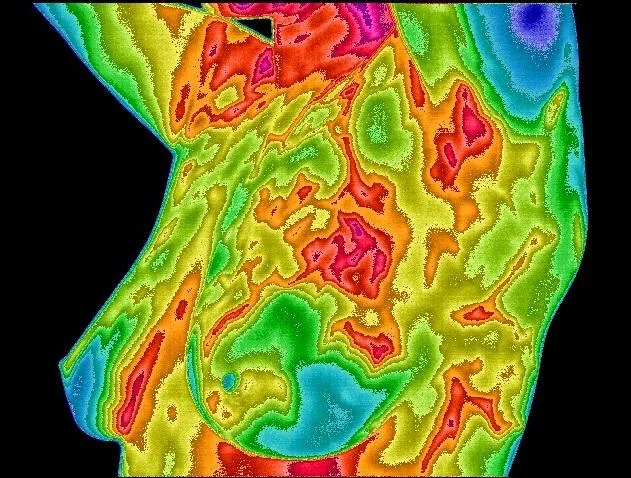
Thermography vs. Mammograms: What Every Woman Needs to Know
Let’s get straight to the point: the routine push for mammograms has become so normalized that questioning it feels taboo (I loooove questioning the mainstream narrative). But if we look past the that narrative and dig into the science, the risks become impossible to ignore. As a holistic practitioner, my goal is to empower you with knowledge and options, not fear. And in my view, thermography is not just an alternative, it's the smarter, safer choice.
A Quick Look at Mammograms: How Did We Get Here?
Mammography became widespread in the 1960s and has since been promoted as the gold standard in early breast cancer detection. The idea behind it is simple: catch abnormalities before they grow. But while that may sound good on the surface, the method itself involves radiation exposure and compression of sensitive breast tissue. The standard advice is that women over 40 should get annual mammograms. That means decades of cumulative radiation, year after year, on breast tissue that may be perfectly healthy.
The Real Risks of Mammograms
Here’s what most mainstream sources don’t highlight:
Mammograms use ionizing radiation, which has been linked to the very thing they aim to prevent—cancer. Each scan may expose you to low levels of radiation, but over time, the risk adds up. This is especially concerning for women with dense breasts, who often require even more frequent imaging or follow-up testing.
Then there’s the issue of compression. Anyone who’s had a mammogram knows the procedure isn’t exactly gentle. Some experts believe that compressing tumors (if present) could potentially cause cancerous cells to spread. While this hasn’t been widely acknowledged in conventional medicine, the concern is real and valid in holistic circles.
False positives are another massive issue. A positive mammogram can lead to unnecessary biopsies, surgeries, and long-term stress, all of which carry their own set of risks. Overdiagnosis means finding "cancer" that may never have posed a threat, leading to overtreatment.
Enter Thermography: A Safer, Smarter Option
Thermography, also known as digital infrared thermal imaging, detects heat patterns and blood flow in body tissues. Unlike mammograms, it doesn't require radiation or compression. Instead, it captures temperature changes that may indicate inflammation or abnormal cell activity—often years before structural changes appear on a mammogram.
Thermography is completely non-invasive. It’s safe, painless, and can be done frequently without health risks. In the hands of a qualified practitioner, it can offer meaningful early detection and ongoing monitoring, especially when combined with a broader holistic view of breast health.
Despite its benefits, thermography isn’t embraced by mainstream medicine. Why? It doesn't fit into the one-size-fits-all model. It requires individualized interpretation and often encourages lifestyle changes rather than pharmaceutical or surgical intervention. But that’s exactly why it’s so powerful.
Is Thermography Enough on Its Own?
In my opinion, yes. Many holistic practitioners and forward-thinking medical professionals use thermography as their primary tool for breast screening. While critics argue it's not a replacement, the truth is: no screening tool is perfect. But thermography doesn’t expose you to harm in the process. That’s a trade-off worth considering.
What You Can Do Today
Start asking questions. Be your own advocate. If something doesn’t feel right, it probably isn’t. Explore thermography providers near you. Learn about lymphatic support, reducing toxic load, and nourishing your body with real, whole foods. Breast health isn't about fear; it’s about support, awareness, and choice.
I share this not to create panic, but to offer you a different lens...one that aligns with safety, prevention, and self-trust.
If you want to learn more about holistic breast health options, or find a trusted thermography provider, I’m happy to help! You deserve care that feels right, not routine.
-- Briana
Sources:
International Academy of Clinical Thermology. Thermography Education & Research. Retrieved from https://iamtonline.org
Gofrit ON, Hain D, Shapiro A, et al. (1997). X-ray-induced DNA double-strand breaks in human peripheral blood lymphocytes: Dependence on radiation dose and individual radiosensitivity. International Journal of Cancer, 74(6), 693–697. https://pubmed.ncbi.nlm.nih.gov/9262257
Jockers, D. (n.d.). Thermography for Breast Screening. Retrieved from Dr. Jockers: https://drjockers.com/thermography-breast-screening
Narod SA, Iqbal J, Giannakeas V, Sopik V, Sun P. (2016). Breast cancer mortality after a diagnosis of ductal carcinoma in situ. JAMA Oncology, 1(7), 888–896. https://pubmed.ncbi.nlm.nih.gov/19454801
